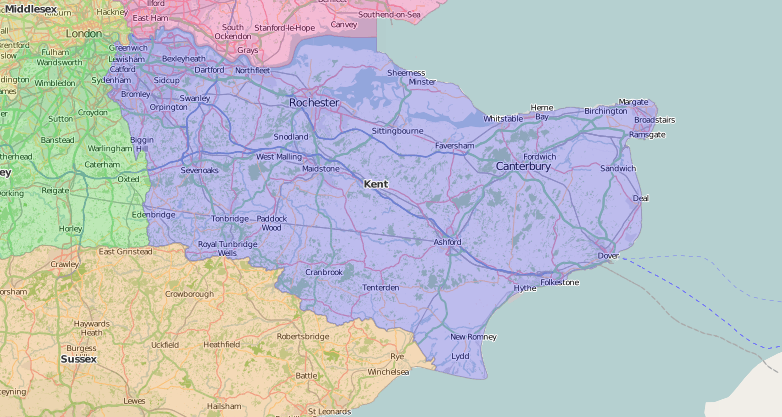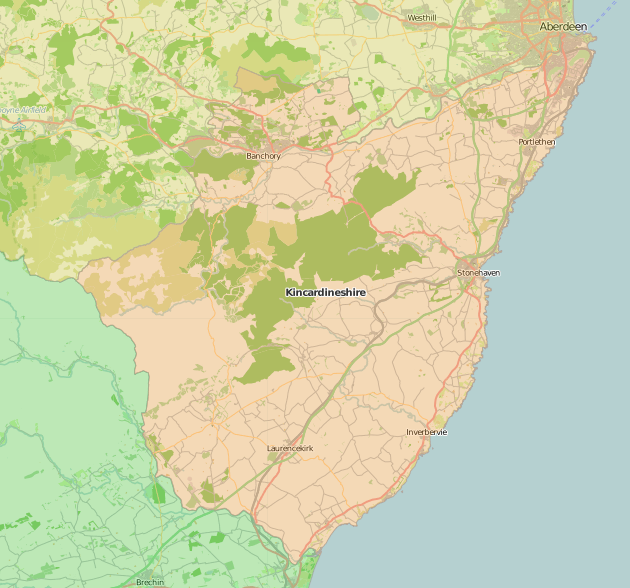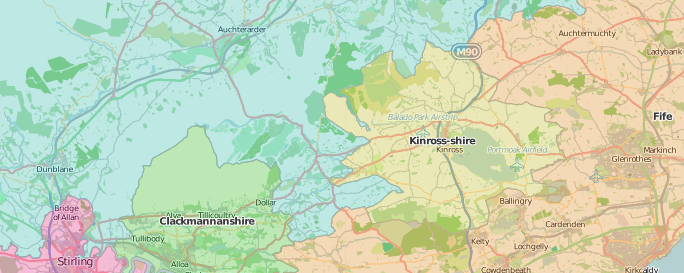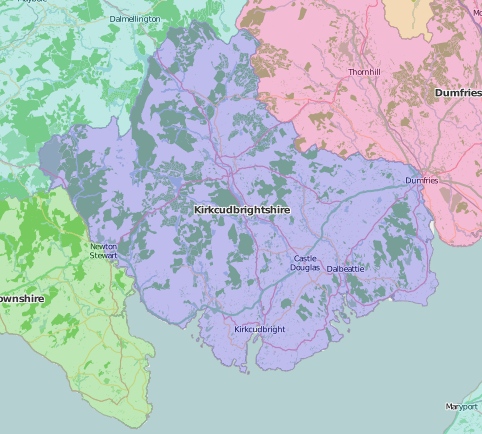
From the north-east to the south-west coasts of Scotland, via Loch Leven, and down to the south-east corner of England.
Kent in c.1612 is already a county of orchards, hop- and vegetable-growing, with distinctive county divisions of lathes rather than hundreds. The county’s proportions fit neatly onto the plate used for Speed’s map, with space in the lower corners for plans of the two cathedral cities of Canterbury and Rochester. There is less emphasis on battles than in other counties, although within a generation there were ‘groans’ and ‘bloody news’ from Kent during the English Civil War. Kent has the distinction of having the first county history, published in 1576 by Speed’s contemporary, William Lambarde (1536-1601).
Edward Hasted (1732-1812) spent 40 years labouring over his county history, with many helpers, notably the surgeon, naturalist, and mayor of Sandwich, William Boys (1735-1803), who published his own collections of local history and natural history. Hasted’s History and topographical survey was published in 4 folio volumes (1778-1799) and – re-edited by others – in 12 octavo volumes (1797-1801), and in many reprints since, although the 1886 edition didn’t make it past Blackheath. Several 19th century writers made time from their main historical interests – theatre costume, coins, or forging works by Shakespeare – to write about Kent: W. H. Ireland’s ‘new and complete history of the county of Kent’ (1828-1830), Charles Roach Smith’s Antiquities of Richborough, Reculver and Lymne (1850), and Planché’s study of the ‘corner of Kent’ that was his son-in-law’s parish of Ash-next-Sandwich (1854).
In a lighter vein, Special Collections holds James John Hissey’s A holiday on the road: an artist’s wanderings in Kent, Sussex, and Surrey (1867) and The Kentish coronal; consisting of original contributions, in prose and poetry by persons connected with the county of Kent (1841), with bookplates of former owners who perhaps had their own Kentish connections.

Kincardineshire despite the natural boundary of the River Dee, and settlement from the Picts onwards, is hard to pin down. The General Views series of 1795 describes it as ‘the County of Kincardine or the Mearns’ and Patrick Chalmers describes the Pictish symbol stone ‘at Fordoun in the Mearns’ in his study of ancient sculptured monuments in 1848 – the year Queen Victoria’s visit put the Royal into Deeside. But in William MacGillivray’s posthumous Natural History (1855) the area remained plain ‘Dee side and Braemar’.

Kinross-shire is second only to Clackmannanshire as the smallest Scottish county, and the two alternated having an MP in the British parliament from the Acts of Union up to 1832, when the combined constituency of Clackmannan and Kinross-shire was created. Their first MP was Admiral Sir Charles Adam (1780-1853) and a generation later his son, William Patrick Adam (1823-1881), held the seat from 1859 until his death. Earlier generations of the Adams family were known for architecture rather than politics, as seen at the family estate of Blair Adam, Kinross-shire. Two books from the library there, initially built up by John Adam (1721-1792) have arrived in Special Collections with the signature and armorial bookplate of William Patrick Adam and appropriate parliamentary subject matter: Henry Elsynge’s 1679 edition of The ancient method and manner of holding parliaments in England, and Proceedings, precedents, and arguments, on claims and controversies, concerning Baronies by Writ, and other honours (1734).

Kirkcudbrightshire, also known as the Stewartry or County of Kirkcudbright, is commended in the Board of Agriculture’s General Views series for “pasture of a luxuriancy and richness scarcely anywhere else to be met with” and its coast as “one of the most eligible situations in the Island, in point of natural advantages, for a trading or manufacturing district”.
Two of the areas more unconventional traders were the pedlar-poet William Nicholson (1783-1849), and the famous Gypsy Billy Marshall, ‘King of the Galloway Tinkers’.
Special Collections classmarks of items cited:
Kent
- The groans of Kent: or, An humble remonstrance from divers well-affected in the county of Kent: To His Excellency the Lord Generall Fairfax, and the army under his command (approximately 1648): SPEC Knows. pamph 479(06)
- Bloudy nevves from Kent: being a relation of the great fight at Rochester and Maidstone, betwixt the Parliaments army under the comand of the Lord Generall Fairfax, and the Kentish forces commanded by Generall Hales. With the number that were slain and taken prisoners, and list of the Kentish commanders, and the town of Maidstone taken (1648): SPEC Knows. pamph 479(11)
- William Lambarde (1536-1601), A perambulation of Kent: conteining the description, hystorie, and customes of that shyre, written in … 1570; first published in … 1576, and now increased and altered after the author’s owne last copie (1596): SPEC Y59.3.14
- Edward Hasted (1732-1812), The history and topographical survey of the county of Kent (Canterbury: 1797-1800): SPEC R.20.1/A
- Edward Hasted, Hasted’s History of Kent, corrected, enlarged, and continued to the present time … Edited by H.H. Drake (1886): SPEC Q2.15/oversize
- William Boys (1735-1803), Collections for an history of Sandwich in Kent, with notices of the other Cinque Ports and members and of Richborough (Canterbury: 1792): SPEC Y79.3.377
- Testacea minuta rariora, nuperrime detecta in arena littoris Sandvicensis; a Gul. Boys, Arm. S. A. S. multa addidit, et omnium figuras ope Microscopii ampliatas accurate delineavit. Geo. Walker. = A collection of the minute and rare shells, lately discovered in the sand of the sea shore near Sandwich; By William Boys, Esq; F. S. A. Considerably augmented, and all their Figures accurately drawn, as magnified with the Microscope. By Geo. Walker, Bookseller, at Faversham (1784): SPEC Y78.4.36
- William Henry Ireland, England’s topographer; or, A new and complete history of the county of Kent; from the earliest records to the present time, including every modern improvement Embellished with a series of views from original drawings by G. Shepherd, H. Gastineau, &c. with historical, topographical, critical & biographical delineations (1828-1830): SPEC Y82.3.620
- Charles Roach Smith, The antiquities of Richborough, Reculver and Lymne, in Kent (1850): SPEC Y85.3.233
- James Robinson Planché (1796-1880), A corner of Kent; or, some account of the parish of Ash-next-Sandwich (1864): SPEC Ryl.B.4.05
- James John Hissey, A holiday on the road: an artist’s wanderings in Kent, Sussex, and Surrey (1867): SPEC Y86.3.37
- Henry Gardiner Adams (1811 or 1812-1881), The Kentish coronal; consisting of original contributions, in prose and poetry by persons connected with the county of Kent (1841): SPEC Annuals 1a.K315
Kincardine
- James Donaldson, General view of the agriculture of the County of Kincardine or the Mearns (1795): SPEC Y79.3.972
- MacGillivray, William, 1796-1852, The natural history of Dee side and Braemar. Edited by Edwin Lankester, M.D., F.R.S. (1855): SPEC Y85.3.202
- Patrick Chalmers (1802-1854), The Ancient sculptured monuments of the county of Angus, including those at Meigle in Perthshire and one at Fordoun in the Mearns (1848): SPEC E.L.7.6
Kinross-shire
- Henry Elsynge (1577-1635 or 1636), The ancient method and manner of holding parliaments in England. 4th edition, enlarged (1679): SPEC H29.44
- Arthur Collins (1682?-1760), Proceedings, precedents, and arguments, on claims and controversies, concerning Baronies by Writ, and other honours (1734): SPEC R.12.7/oversize
Kirkcudbrightshire
- Great Britain. Board of Agriculture, General view of the agriculture of Galloway, comprehending the stewartry of Kirkudbright and shire of Wigton. With observations on the means of its improvement. By James Webster (1794): SPEC Y79.3.291(6)
- William Nicholson (1783-1849), The poetical works of William Nicholson; with a memoir by M. McL. Harper. 4th ed (Dalbeattie, 1897): SPEC Fraser 1648
- Andrew McCormick, Billy Marshall, the Caird of Barullion, the King of the Galloway Tinkers (1905): SPEC Scott Macfie F.1.16(3)
- Andrew McCormick, The Tinkler-Gypsies (1907): SPEC Scott Macfie A.4.16